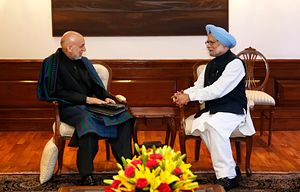This is a landmark year for Afghanistan. After more than a decade of war, the country is set to transition into a new era, one it hopes will be less turbulent and will offer the beleaguered nation peace, stability and growth. Over the coming year, Afghanistan is scheduled to undergo a political transition, courtesy the presidential elections due in April, and a security transition (already underway), with the full withdrawal of international combat troops by the end of this year.
While the political process is underway and is seen as more of an internal decision for the Afghan people to make, the security transition holds the key to a secure future for Afghanistan. Critical to this is the Bilateral Security Agreement (BSA) with the U.S. Although the BSA has been finalized and was even cleared by a loya jirga (an assembly of elders) in Afghanistan last November, President Hamid Karzai has not been willing to sign it, much to the frustration of Washington, which warns that a “zero option” could have adverse consequences for Afghanistan’s security post 2014. With the current impasse unlikely to be broken soon, Karzai is looking at “Plan B” options. In this context, Iran and India may have a role to play. Given their strategic interests in Afghanistan as well as trends over the past months, these two countries could well offer Afghanistan a critical lifeline during a period of transition and uncertainty.
Events in recent months indicate to three clear policy strands. First, Karzai is unwilling to sign the BSA soon (at least until the April presidential elections) and is looking for bigger bargains. Second, visits by Karzai and his ministers to Iran and India in recent months are clearly aimed at shoring up support in a situation where U.S. military support may not be forthcoming. And third Karzai is now hedging his bets when it comes to direct talks with the Taliban given the absence of any clear initiative by the U.S. In all of these initiatives, India and Iran could be key players.
Take Karzai’s trips to India and Iran in December last year. Both visits came after the BSA was passed by a loya jirga and, interestingly, shortly after Iran and the U.S.-led P5+1 had signed an interim deal on the Iran nuclear issue. While in Iran, Karzai found support when President Hassan Rouhani declared, “We are concerned about the tensions arising from the presence of foreign forces in the region and believe that all foreign forces should exit the region and Afghanistan’s security should be ceded to the people of that country.” Coming from Iran at that juncture, it was a major show of support for Karzai. The two countries also agreed to sign a “pact of friendship and cooperation,” which could include aspects of political, security cooperation and economic development. This would complement a separate border and security agreement signed earlier in August.
Karzai’s visit to India immediately after this, on December 13, was aimed not only at consolidating support but also at pleading for increased military assistance. In his previous visit to New Delhi in May 2013, he had handed over a wish list of lethal and non-lethal military aid from India that included artillery guns, helicopters and armored tanks. In his December trip, he not only reiterated his requests but is reported to have asked India for a more proactive involvement in getting the Afghanistan National Security Forces (ANSF) ready to take on the Taliban post 2014. India confirmed its commitment to deepening defense and security cooperation, through enhancements in training, meeting the equipment and infrastructure needs of ANSF and opportunities for higher military education in India for Afghan officers. While emphasizing the need to sign the BSA, India refrained from putting any overt pressure on Karzai, stating that it shared his wish to have the BSA, but will not be “prescriptive, intrusive or judgmental.”
While Iran and India have always been potential alternatives for Afghanistan, it is only in the past few months that Kabul seems to have been getting traction on this option. The Iran nuclear deal has perhaps unshackled some of the constraints India may have felt seeking Iran’s support in finding an optimal solution for Afghanistan. The meeting of Indian National Security Adviser Shivshankar Menon with Iran’s Foreign Minister Javad Zarif on February 1 at the Munich Conference to discuss recent developments in Afghanistan was significant. Discussion centered on India-Iran cooperation in dealing with the situation in Afghanistan, especially in the context of the rift between Washington and Karzai. Iranian President Rouhani is likely to dispatch the secretary of Iran’s Supreme National Security Council, Ali Shamkhani, to Delhi soon to discuss the issue. Reports of direct talks between Karzai and the Taliban have also evoked a positive response in India, leading to the likelihood of India’s foreign minister vising Kabul in March 2014. With India as its most trusted ally and an “all-weather friend” and Iran as an immediate neighbor and part of its political and cultural history, Afghanistan is clearly working on a simultaneous plan to secure its post-2014 future, with or without a BSA with the U.S. With their strategic interests and cordial relations with Kabul, India and Iran will be critical to a peaceful transition for Afghanistan post 2014 and could well be that country’s Plan B.
Rajeev Agarwal is a Research Fellow at IDSA, New Delhi. His specializations include West Asia and Afghanistan.

































